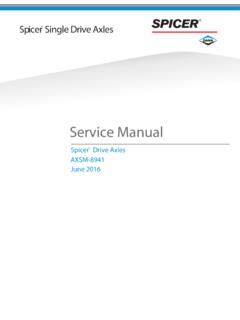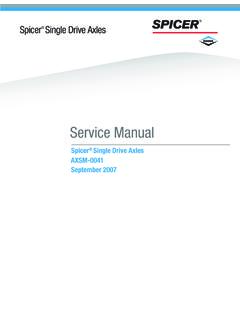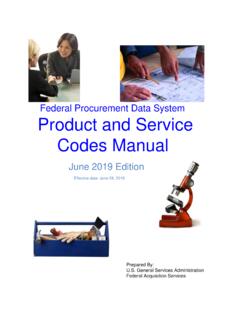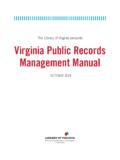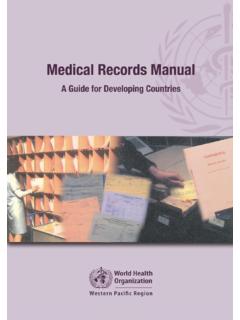Transcription of Service Manual - media.spicerparts.com
1 Spicer Single Drive Axles Ser vice ManualAXSM-8941 June 2016 Spicer Drive AxlesGeneral InformationGeneral InformationThe description and specifications contained in this Service publication are current at the time of printing. Dana Corporation reserves the right to discontinue or to modify its models and/or procedures and to change specifications at any time without reference to brand names in this publication is made simply as an example of the types of tools and materials recommended for use and should not be considered an endorsement. Equivalents, if available, may be symbol is used throughout thismanual to call attention to procedureswhere carelessness or failure to followspecific instructions may result in personalinjury and/or component from the instructions, choice oftools, materials and recommended partsmentioned in this publication mayjeopardize the personal safety of theservice technician or vehicle : Failure to follow indicatedprocedures creates a high risk of personalinjury to the servicing : Failure to follow indicated proceduresmay cause component damage or : Highly recommended proceduresfor proper Service of this : Additional Service information not coveredin the Service .
2 Helpful removal and installation proceduresto aid in the Service of this use genuine Dana replacement NoticeTable of ContentsTable of ContentsTable of Contents - VisualWheelDifferentialAssemblypage 17 CarrierAssemblypage 8 DrivePinionpage 12 PinionSealspage 12 HousingBreatherpage 26 Lubricationpage 33 WheelEnd Sealpage 28 Table of ContentsTable of ContentsGeneral InformationIntroduction .. 1 Model Identification .. 2 Parts Identification .. 3 Ring Gear and Pinion .. 4 InspectionFailure Analysis .. 5 Prepare the Parts for Inspection .. 6 Inspection .. 7 Clean .. 7 Inspect Axle Housing .. 7 Inspect Primary Gearing .. 7 Differential Carrier Assembly Differential Carrier Assembly - Exploded View .. 8 Removal of Differential Carrier From Axle Housing .. 9 Install Differential Carrier .. 10 Remove Wheel Differential .. 11 Pinion AssemblyRear Axle Pinion Assembly - Exploded View .. 12 Remove Pinion Assembly .. 13 Install Pinion Assembly.
3 15 Wheel Differential AssemblyWheel Differential Assembly - Exploded View .. 17 Disassemble, Overhaul and Assemble Wheel Differential .. 18 Disassemble Wheel Differential .. 18 Overhaul and Assemble Wheel Differential.. 20 Wheel Differential AdjustmentsMeasure and Adjust Carrier Assembly(Adjust Backlash and Preload) .. 22 Change Backlash Setting .. 23 Adjust Tooth Contact PatternAdjust Ring and Pinion Tooth Contact Pattern .. 24 Adjust Ring Gear Position (Backlash) .. 25 Housing BreatherInstall New Axle Housing Breather - (Metal and Plastic) ..26 Axle HousingAxle Housing - Exploded View ..27 Wheel End SealWheel End Seal Parts - Exploded View ..28 Remove and Overhaul Wheel End Seal ..29 Install Wheel End Seal .. 29 Wheel Adjustment SystemsAdjust Wheel Bearing ..30 Wheel EndsVerify Wheel End-Play Procedure ..32 LubricationLubricate Wheel End ..33 General Lubrication Information ..35 Approved Lubricants ..35 Recommendations for Viscosity/Ambient Temperature.
4 35 Lube Change Intervals ..36 Change Lube ..37 Drain .. 37 Fill .. 37 Proper Vehicle TowingWith Truetrac Limited Slip Differential.. 38 Torque Flow..39 Parts IdentificationRear Drive Axle Parts - Exploded View ..40 Torque SpecificationsFastener Torque Specifications ..41 Service ToolsRecommended Service Tools ..421 General InformationGeneral InformationIntroductionDana Corporation presents this publication to aid in mainte-nance and overhaul of Dana single reduction drive axles. Instructions contained cover the models listed below. Their design is common, with differences in load capacity. Capacity variations are achieved by combining basic differential carrier assemblies with different axle housings, axle shafts, and wheel ListingThe following models are included in this publication:Dana Single Reduction Axles With Standard Wheel DifferentialS135LS135NS135SS150LS150NS15 0SS 135 SSpicerGearing TypeS = Single ReductionL = True Trac DifferentialN = No SpinNominal LoadCarrying Capacity135 = 13,500 = 15,500 InformationModel IdentificationData plate is located on the axle centerlineRear Axle(Top View)43512 SER #620112(P) CARRIER #Spicer MODEL PART NO.
5 RATIOMADE PART - Customer part number (optional)2 - Dana part number3 - Julian date code4 - Line set number (optional)5 - Last six digits of vehicle serial number (optional)360CR100 6 XSPICERRATIO94070R1 InformationGeneral InformationParts IdentificationAxle HousingAxle ShaftJulian Date Code1 - Dana part number2 - Customer part number (optional)3 - Model4 - Julian date code5 - Line set number (optional)6 - Last six digits of vehicle serial number (optional)1 - Axle shaft part number43612 SER # 620112360RF100-6 MODEL S135-SRATIO R1 424254194 070 Model YearDay of Year4 General InformationRing Gear and PinionManufacturer s Date - Date gear set was Trademark - Company logo and location of manufac-turing - Part number of pinion gear. (TYPICAL)Tooth Combination ( 41-11) - Indicates the pinion has 11 teeth and the ring gear has 41 teeth which results in a :1 Set Number - Spicer ring and pinions are manufac-tured as matched sets. Both ring and pinion are marked with a corresponding number ( 260), which identifies them as a matched gear set that does not have the same match set numbers should not be mated together.
6 If either ring gear or pinion require replacement, a new matched set must be - Spicer trademark2 - Tooth combination3 - Part number4 - Heat code5 - Spicer trademark6 - Manufacturer s date7 - Matched set number41-1126041-1122601345675 InspectionInspectionFailure AnalysisFailure analysis is the process of determining the original cause of a component failure in order to keep it from happen-ing again. Too often, when a failed component is replaced without determining its cause, there will be a recurring failure. If a carrier housing is opened, revealing a ring gear with a bro-ken tooth, it is not enough to settle on the broken tooth as the cause of the carrier failure. Other parts of the carrier must be examined. For a thorough understanding of the failure and possible insight into related problems, the technician needs to observe the overall condition of the one benefits when a failed component goes on the junk pile with the cause unknown. Nothing is more disturbing to a customer than a repeat failure.
7 Systematically analyzing a fail-ure to prevent a repeat occurrence assures quality Service by avoiding unnecessary downtime and further expense to the true cause of a failure can be better determined by know-ing what to look for, determining how a piece of the equip-ment was running and learning about previous problems. In the case of a rebuilt rear axle, mismatched gears may have been more successful shops prevent repeat equipment failures by developing good failure analysis practices. Knowing how to diagnose the cause of a premature failure is one of the pre-requisites of a good heavy-equipment to Diagnose a FailureThe following five steps are an effective approach to good fail-ure the a preliminary the parts for the cause of the the cause of the the ProblemHere are some guidelines for starting to learn about a failure, including questions to ask: Talk to the operator of the truck. Look at the Service records. Find out when the truck was last serviced.
8 Ask: In what type of Service is the truck being used? Ask: Has this particular failure occurred before? Ask: How was the truck working prior to the failure?You need to be a good listener. Sometimes, insignificant or unrelated symptoms can point to the cause of the failure. Ask: Was the vehicle operating at normal tempera-tures? Ask: Were the gauges showing normal ranges of operation? Ask: Was there any unusual noise or vibration?After listening, review the previous repair and maintenance records. If there is more than one driver, talk to all of them and compare their observations for consistency with the ser-vice and maintenance records. Verify the chassis Vehicle Identification Number (VIN) number from the vehicle identifi-cation plate, as well as the mileage and hours on the a Preliminary InvestigationThese steps consist of external inspections and observations that will be valuable when combined with the results of the parts examination. Look for leaks, cracks, or other damage that can point to the cause of the failure.
9 Make note of obvious leaks around plugs and seals. A missing fill or drain plug would be an obvious cause for concern. Look for cracks in the carrier housing (harder to see, but sometimes visible). Does the general mechanical condition of the vehicle indicate proper maintenance or are there signs of neglect? Are the tires in good condition and do the sizes match? If equipped with a torque-limiting device, is it work-ing properly?During the preliminary investigation, write down anything out of the ordinary for later reference. Items that appear insignifi-cant now may take on more importance when the subassem-blies are torn the Parts for InspectionAfter the preliminary investigation, locate the failure and pre-pare the part for examination. In carrier failure analysis, it may be necessary to disassemble the unit. When disassembling subassemblies and parts, do not clean the parts immediately since cleaning may destroy some of the evidence. When tearing down the drive axle, do it in the recom-mended manner.
10 Minimize any further damage to the unit. Ask more questions when examining the interior of the carrier. Does the lubricant meet the manufacturer specifications regarding quality, quantity, and vis-cosity? As soon as you have located the failed part, take time to analyze the the Cause of the FailureHere begins the real challenge to determine the exact cause of the failure. Keep in mind that there is no benefit to replacing a failed part without determining the cause of the failure. For example, after examining a failed part and finding that the fail-ure is caused by a lack of lubrication, you must determine if there was an external leak. Obviously, if there is an external leak, just replacing the failed gear is not going to correct the important consideration here is to determine the spe-cific type of failure which can be a valuable indicator for the cause of failure. The following pages show different types of failures and possible causes. Use this as a guide in determin-ing types of failures and in correcting the Cause of the ProblemOnce the cause of the problem has been determined, refer to the appropriate Service Manual to perform the steel parts with ground or polished surfaces in solvent.
